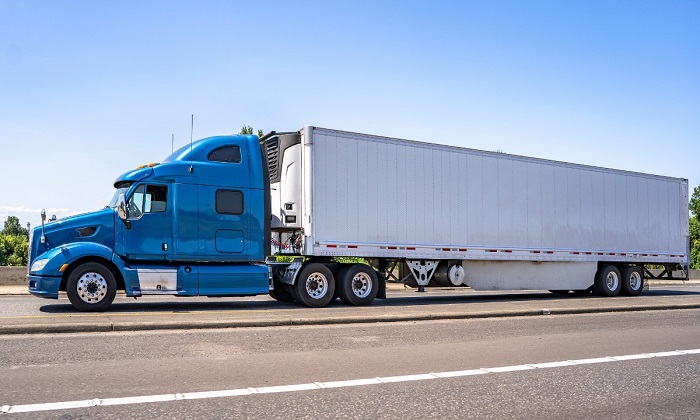Ensuring the integrity of dairy freight in northern Ohio demands a precise cold-chain strategy tailored for dry-van transport. Unlike refrigerated reefers, dry vans require advanced solutions — such as bulkheads and temp probes — to maintain consistent reefer temps critical for safe milk hauling. The Ohio cold chain plays a vital role in preserving dairy quality, supporting essential processes like pasteurization and cold soak. Adhering to HACCP guidelines, shippers must monitor temperature fluctuations meticulously to prevent spoilage and ensure compliance. This article explores the unique challenges and best practices for managing dry-van temp controls in Ohio’s dynamic dairy industry, offering insights that optimize freshness from farm to processing plant.
2. Temperature Challenges in Northern Ohio Dry-Van Milk Hauls
Northern Ohio’s variable climate poses significant temperature challenges for dry-van milk hauling, demanding rigorous cold-chain controls to protect dairy freight. Key hurdles include:
- Wide Temperature Swings: Seasonal shifts from frigid winters to warm summers cause fluctuating dry-van temps, risking milk quality without consistent monitoring.
- Limited Insulation in Dry Vans: Unlike reefers, dry vans lack built-in cooling, making it critical to use bulkheads and temp probes to maintain stable internal conditions.
- Cold Soak Effects: Prolonged stops in cold environments can create uneven temperatures inside the van, challenging HACCP compliance and risking spoilage.
- Heat Exposure During Loading/Unloading: Brief exposure to outside heat can spike dry-van temp, impacting sensitive dairy products before pasteurization.
- Inconsistent Airflow: Dry vans may experience hot spots due to poor circulation, necessitating strategic product placement and air ventilation.
- Monitoring Difficulties: Without real-time reefer temp feedback, shippers must rely on advanced temp probes and data loggers to ensure continuous cold-chain integrity.
Addressing these challenges is essential for maintaining milk freshness and meeting Ohio cold chain standards, supporting the local dairy industry’s rigorous safety and quality demands.
3. Understanding Dry-Van Temp Control: Bulkhead and Reefer Temp Considerations
Effective dry-van temp control is crucial for maintaining dairy freight quality within the Ohio cold chain. Unlike reefers, dry vans lack built-in refrigeration, making bulkheads an essential barrier that helps isolate temperature zones and reduce heat transfer during milk hauling. Proper installation minimizes cold soak effects by stabilizing internal air, supporting consistent reefer temps vital for HACCP compliance. Temp probes placed strategically throughout the van provide accurate monitoring, alerting shippers to fluctuations that could compromise pasteurization standards. By combining bulkhead usage with real-time temp data, carriers can better manage airflow and prevent hot spots, ensuring milk remains within safe temperature ranges throughout transport. Understanding these dry-van temp control factors enhances the reliability of Ohio’s dairy cold chain, protecting product freshness from farm pickup to processing plant delivery.
4. Pre-Cool Strategies vs Continuous Run and Start-Stop Methods
When managing dry-van temp for dairy freight in northern Ohio, choosing the right cooling strategy is critical to maintaining the Ohio cold chain. Here’s how pre-cool strategies compare to continuous run and start-stop methods:
- Pre-Cool Strategies:
- Involve chilling the dry van and bulkhead before loading milk to reduce initial heat load.
- Minimize cold soak by stabilizing reefer temp early, helping dairy products meet HACCP pasteurization standards.
- Depend heavily on accurate temp probe data for timing and effectiveness.
- Continuous Run Method:
- Maintains constant refrigeration throughout transit, ensuring steady dry-van temp.
- Reduces temperature fluctuations but can increase fuel consumption and wear on refrigeration equipment.
- Start-Stop Method:
- Cycles refrigeration units on and off to conserve energy.
- Risks uneven cooling and hot spots, increasing the chance of cold soak and temp deviations during milk hauling.
Balancing these methods with bulkhead use and precise monitoring ensures optimal temp control, preserving dairy quality from farm to plant in Ohio’s challenging climate.
5. Role of Cold Soak and Temp Probe Accuracy in Maintaining Milk Quality
Cold soak significantly impacts dry-van temp stability during milk hauling, especially in northern Ohio’s fluctuating climate. Extended exposure to low temps can lead to uneven cooling, risking milk quality and HACCP compliance. Accurate temp probes are vital to detect cold soak effects and monitor reefer temp variations in real time. Precise probe placement near the bulkhead and product zones ensures reliable data, allowing carriers to adjust cooling strategies proactively. By minimizing cold soak and leveraging accurate temp readings, shippers strengthen the Ohio cold chain, preserving milk freshness and supporting effective pasteurization. Integrating these practices is essential for optimizing dry-van temp control and safeguarding dairy freight integrity throughout transit.
6. HACCP Protocols and Pasteurization Implications in Cold-Chain Management
Adhering to HACCP protocols is paramount for maintaining dairy freight safety within the Ohio cold chain, especially in dry-van milk hauling where temp control is less direct than reefers. HACCP guidelines mandate strict monitoring of dry-van temp to prevent microbial growth that can compromise pasteurization efficacy. Temperature deviations — whether from cold soak effects or heat exposure during loading — pose risks that can invalidate pasteurization, leading to product spoilage or regulatory non-compliance.
Implementing precise temp probe placement near bulkheads and key product zones ensures real-time data critical for HACCP compliance. Continuous reefer temp tracking enables prompt corrective actions to maintain the pasteurization window, safeguarding milk quality from farm pickup through transit. Moreover, integrating pre-cool strategies and minimizing cold soak with accurate temp monitoring supports HACCP’s preventive approach by stabilizing internal dry-van temps.
Ultimately, rigorous HACCP adherence combined with strategic cold-chain management fortifies the pasteurization process, ensuring that northern Ohio’s dairy freight meets safety standards and reaches processing plants in optimal condition. This synergy enhances overall cold-chain integrity, protecting product freshness and public health —learn more about how Cleveland’s dry van operators support this supply chain.
7. Best Practices for Optimizing Milk Hauling in Northern Ohio
Optimizing milk hauling within the Ohio cold chain demands a strategic blend of technology and procedure. First, ensure precise dry-van temp management by installing bulkheads to separate temperature zones and reduce cold soak, maintaining stable reefer temps critical for dairy freight quality. Use multiple temp probes strategically placed near product zones and bulkheads for real-time monitoring, enabling quick response to fluctuations. Employ pre-cool strategies before loading to minimize initial heat load and support HACCP-compliant pasteurization standards. Avoid prolonged stops that exacerbate cold soak effects, and streamline loading/unloading to reduce heat exposure. Regular calibration of temp probes guarantees accuracy, essential for maintaining milk freshness. By integrating these best practices, carriers in northern Ohio can uphold stringent cold-chain controls, safeguarding milk quality from farm pickup to processing plant delivery.
8. Conclusion: Enhancing Cold-Chain Reliability for Dairy Freight
Ensuring cold-chain reliability is paramount for dry-van dairy freight in northern Ohio, where temperature-sensitive products demand precise handling. Throughout this guide, we explored critical factors such as optimal temperature settings, advanced insulation techniques, and real-time monitoring technologies that safeguard milk and dairy goods from spoilage. We highlighted the importance of thorough pre-cooling and strategic routing to minimize transit times and exposure to temperature fluctuations. Driver training and adherence to best practices in loading and unloading further contribute to maintaining product integrity.
By integrating these insights, dairy carriers can significantly reduce spoilage risks, enhance product quality, and boost customer satisfaction. Investing in cold-chain innovations not only complies with stringent food safety regulations but also strengthens competitive advantage in the dairy logistics sector. As northern Ohio’s climate poses unique challenges, a robust cold-chain strategy tailored to regional conditions is essential. Emphasizing continuous improvement and data-driven decision-making will drive reliability and efficiency, ensuring fresh dairy products reach consumers safely and promptly. Prioritizing cold-chain excellence transforms dry-van freight from a logistical hurdle into a strategic asset for the dairy industry.









Leave a Reply